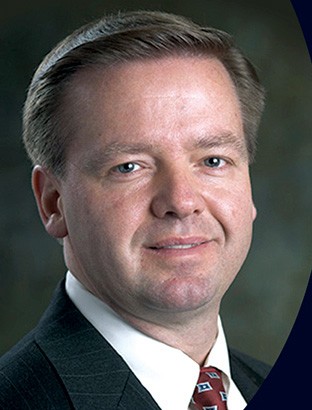Creating a Legacy of Breakthroughs
Pete Valenti is a turnaround man.
For almost three decades, he has built a career out of going into businesses with slow or negative growth and creating transformations that drive innovation and sustainable change. It is his legacy—and one that he is proud of. “I love to see people and organizations win,” says Mr. Valenti, who is division president of breast and skeletal health solutions at Hologic.
His breakthroughs are not simply about bringing better products to market faster, however. To Mr. Valenti, it is also vital to alter the mindsets of the people who make up an organization. “It’s about what excites people, what gets them believing in the future and thinking differently about what they can do personally to impact their situation,” he says. “Launching a better new product is one thing. Creating a culture that’s always looking to do things better, creating an organization that will win for decades to come—that’s the ultimate goal.”
It is a goal he and his teams have achieved at various Johnson & Johnson businesses, including K-Y brand and Vistakon, at Bausch + Lomb, and now at his current organization, Hologic. The company develops and manufactures diagnostic and surgical products and medical imaging systems related to women’s health.
 But in each case, the breakthroughs he helped create almost did not happen. The reason, he says, is simple: People and organizations inherently resist change and favor the status quo. “Organizations’ momentum, thinking and in some cases management processes are all against driving that kind of big change,” he says.
But in each case, the breakthroughs he helped create almost did not happen. The reason, he says, is simple: People and organizations inherently resist change and favor the status quo. “Organizations’ momentum, thinking and in some cases management processes are all against driving that kind of big change,” he says.
In addition, companies create what Mr. Valenti calls “artificial criteria”—hurdles designed to make decision-making simpler, such as a minimum amount of revenue a proposed new product must guarantee before it can be produced, that in fact can stifle big ideas. “So it takes bold thinking and bold positioning to get those breakthroughs.”
Shifting Mindsets
When it comes to innovation, barriers to entry often start at the top. Such was the case for Johnson & Johnson’s K-Y product line. The 60-year-old brand had become tired and growth had flatlined. And yet, company leadership was hesitant to make a change.
The problem? K-Y had long been known as a surgical lubricant, and that was the niche Johnson & Johnson continued to push. But the brand had taken on a life of its own among consumers. Once the product became available over the counter, they started using it as a sexual lubricant. “At Johnson & Johnson, a very conservative company, the idea of products used for better sex was not appealing,” Mr. Valenti says.
But, among many of the rank and file, “the thinking was that the world was bigger than the categories that K-Y played in,” he says.
As Mr. Valenti discovered, K-Y’s R&D team had been developing new product ideas aligned to the brand’s reality—only to watch them languish on cabinet shelves. “The R&D team was afraid to bring them to Johnson & Johnson’s management,” Mr. Valenti says. “They were worried their ideas would be shot down and they’d be seen as going against the Johnson & Johnson culture.”
Once he understood the point of resistance, Mr. Valenti could determine how best to make new products viable. He shifted the organization’s thinking about K-Y products by reframing the brand as helping to build and enhance healthy relationships. They changed the name of his group from Women’s Health to Intimate Health. “When we redefined the category and the thinking about the business as the world of intimate health, then Johnson & Johnson was very open to new products,” he says.
With that shift made, Mr. Valenti and his team began aggressively pursuing the new future they were trying to create, starting with a goal of testing and validating 100 new concepts every quarter. “The mindset became, let’s get ideas, let’s go test them, let’s not try to be perfect,” he says. “Let’s get a lot of shots on goal and then from there assess where we want to go.”
Under the Intimate Health banner, Mr. Valenti’s team ended up launching new K-Y products that generated tens of millions of dollars in annual revenue. As a result, K-Y’s sales grew fivefold over the next five years.
Seek Out Innovation
 At Bausch + Lomb, Mr. Valenti found a scenario similar to the one at K-Y: a stagnant business line that resisted change. The organization’s vision care revenue had been falling for 10 years and employees had become rather jaded. “Winning was a long, long time away,” Mr. Valenti says. “So when we talked about bringing in innovation to drive sustainable growth, the general attitude was, ‘Not going to happen, we’ve heard it before.’”
At Bausch + Lomb, Mr. Valenti found a scenario similar to the one at K-Y: a stagnant business line that resisted change. The organization’s vision care revenue had been falling for 10 years and employees had become rather jaded. “Winning was a long, long time away,” Mr. Valenti says. “So when we talked about bringing in innovation to drive sustainable growth, the general attitude was, ‘Not going to happen, we’ve heard it before.’”
And in fact they had. Mr. Valenti was the seventh leader over Bausch + Lomb’s vision care division in only a decade. So while he could certainly understand his employees’ wariness, he had to get them past it. “Pete had a huge challenge ahead of him; he needed to intervene in the invisible forces that were inhibiting people from thinking differently, often described as the organizational corporate gravity and myopia that ‘certain things just can’t be done’ here at Bausch + Lomb,” says Jennifer Zimmer, a partner at Insigniam.
One of the first things he did to gain buy-in at Bausch + Lomb was make innovation a centerpiece of the organization by rolling it up into its values. “At its core, transformation is about bold goals and bold declarations that make people look at things differently Share on X,” he says.
Mr. Valenti and his team created what would eventually become known as the Patient-Centric Innovation Process, which brought every function together to drive innovation instead of having separate functions on separate teams.
At the same time, Mr. Valenti began looking to outside sources for innovation. He decreed that 40 percent of innovation would come through external partnerships. It was not a magic number, Mr. Valenti explains; it was just a large number. “Whether or not 40 percent was the right number, it was significantly more than we’d ever done. So it made people change their thinking.” Working with outside partners forces an organization’s people to think and work differently.
The 40 percent figure had another benefit: It was less than 50. Mr. Valenti wanted to be clear that, while a big chunk of new ideas would come from external sources, the majority would still be derived internally. He needed to assure a concerned R&D group. “They worried that if we did so much outside, we wouldn’t need them,” he says. Just the opposite turned out to be true. Because Mr. Valenti’s team came up with more product ideas, the R&D team became busier and more valuable.
Ultimately, Bausch + Lomb made major breakthroughs in building an industry-leading new product pipeline, resulting in three new lens materials. Importantly, there were unintended benefits of pushing for breakthroughs. For instance, while driving toward a new lens vision design, the R&D team reduced the design-to-molding time from six months to six weeks on each SKU, and there could be 1,200 SKUs or more for one product. In another case, when shooting for a new low-cost product, they came up with a more efficient and less expensive way to do product sterilization, saving significant time and money that could be applied to other products.
With any transformation, an effective way to overcome people’s resistance to change is to solicit their ideas on how to change, Mr. Valenti says. They then become an active part of the breakthrough, rather than barriers to it.
No Idea Too Bold
At Bausch + Lomb and now at Hologic, Mr. Valenti established a process where employees across the organizations regularly contributed their ideas about how to improve products and processes. Teams of employees from all functions then scored the ideas and the best ones were implemented. Along the way, contests were held to recognize the people and functions with the best or most ideas. The goal is to get this ingrained in the culture, Mr. Valenti says, so people do it every day as part of their routine.
Even ideas that seemed completely off-the-wall were seriously entertained. “If people bring ideas and all you do is sit there and kill the ideas, you won’t generate the risk-taking you want and people won’t step forward with other ideas,” Mr. Valenti says. “You have to ensure, when you’re trying to be open to new ideas, that your first signal isn’t that you killed the first 10 that came in.”
There is another advantage to hearing out even the most far-fetched ideas, Mr. Valenti says: They typically come from vocal employees. Listening to their suggestions sends them a clear signal that the organization is genuine about innovation, and those vocal employees then spread that message to their colleagues, becoming change agents. “To be innovative, you need to engage the whole organization. You can’t do it on your own as a leader,” Mr. Valenti says.
“You have to ensure, when you’re trying to be open to new ideas, that your first signal isn’t that you killed the first 10 that came in.”
—Pete Valenti
“Two of the key leadership principles Pete stands for are inclusion and accountability,” Ms. Zimmer says. “He truly believes that everyone has a contribution to make and is accountable for speaking up. He develops a big-picture vision then walks the talk every step of the way. This builds an energy in the organization where people want to participate.”
Carrying Ideas Through
When Mr. Valenti joined Danbury, Connecticut-based Hologic Division in 2014, he found an organization with a long history of developing market-leading products—while too often going over budget and way over schedule. “Innovation has a broad definition,” he says. “The products [Hologic was] doing were innovative. The how we got them done was not ideal, and the readiness to take them to market was not good.”
Mr. Valenti had to find a way to make better products more efficiently. “It’s not just speed for speed’s sake. It’s doing things faster and better—meaning better alignment with patient and customer needs, quality, safety and regulation.”
The first step was creating a vision statement around innovation, which became the Insights-Driven Innovation Approach. Next, Mr. Valenti brought various functional leads from throughout the organization that had been involved in the successes and failures of the past to decipher what worked and what did not. “[The team members] were high performers from every function,” Mr. Valenti says. “They could help drive change, so instead of just impacting the 30 people in the room who were involved with that team, they were impacting the 1,400 overall that are in the division.”
The team also created the concept of inclusive innovation—Hologic’s form of soliciting, scoring and rewarding employee-driven ideas for change. Through the organization’s first wave of inclusive innovation, it came up with more than 400 suggestions for improving products and processes. Winning ideas ranged from creating a mammography product that enhanced patient comfort to streamlining the organization’s documentation process.
Hologic tested its new approach to innovation and more efficient processes while developing its Affirm Prone Biopsy System. With this new product, the company aimed to take its 3-D imaging mammography technology, which it had launched in Europe in 2009 and in the United States in 2011, and use it on a biopsy table. The product would yield more accurate and less invasive biopsies for women and better workflows for their medical providers.
“In all these transformations, you have to set a bold vision with innovation at its core. You’re driving people to understand that their role is not to accept the status quo but to innovate to make breakthroughs.”
—Pete Valenti
To get there, the team examined the issues that had caused pain in the past. “One of the major breakthroughs was we did not have enough floor space in our plant to physically make the volumes we were forecasting,” says Mr. Valenti.
So the team identified ways to make the product in less space, and the biopsy system is now produced with just 40 percent of the manufacturing footprint that older, similar products required.
As a result of its more efficient process, Hologic completed the new biopsy system eight months faster than anticipated. The product received U.S. Food and Drug Administration approval in April 2016 and has since seen more sales in its first months than any other Hologic product. Orders have doubled every quarter since launch.
“In all these transformations, you have to set a bold vision with innovation at its core,” Mr. Valenti says. “You’re driving people to understand that their role is not to accept the status quo but to innovate to make breakthroughs.”
“This in turn catalyzes the teams to be focused, owning the result and driving high performance,” Ms. Zimmer says. “People love to work hard to deliver what they create. Pete inspires bold, decisive leadership.”



